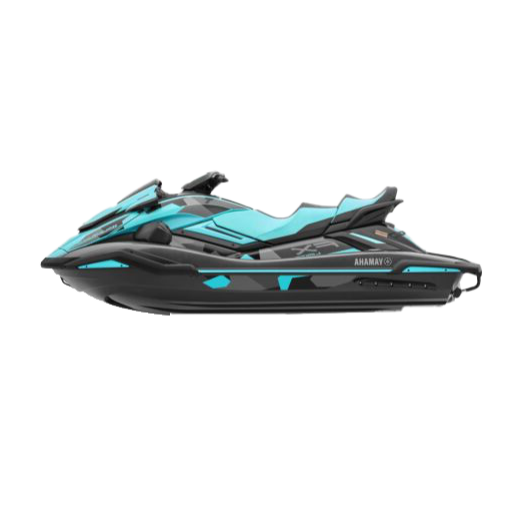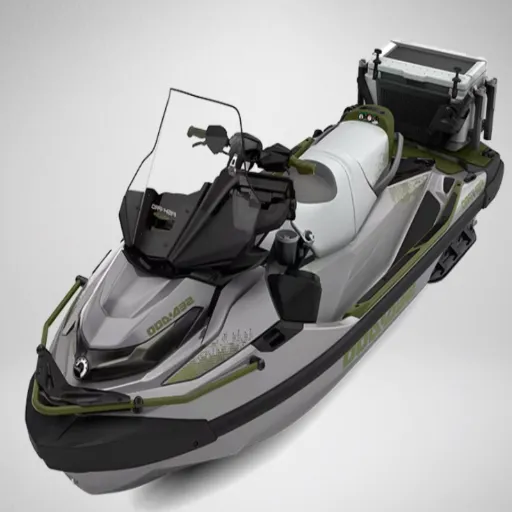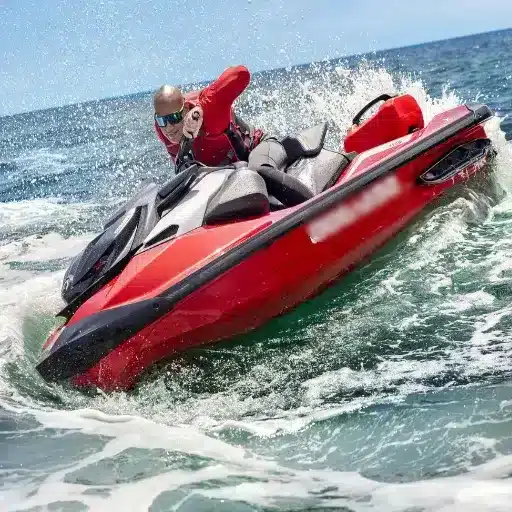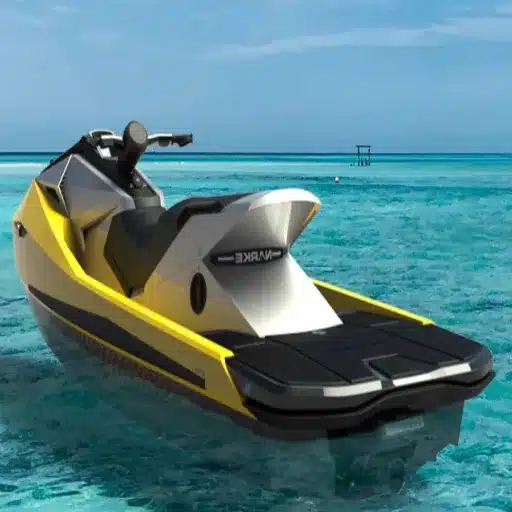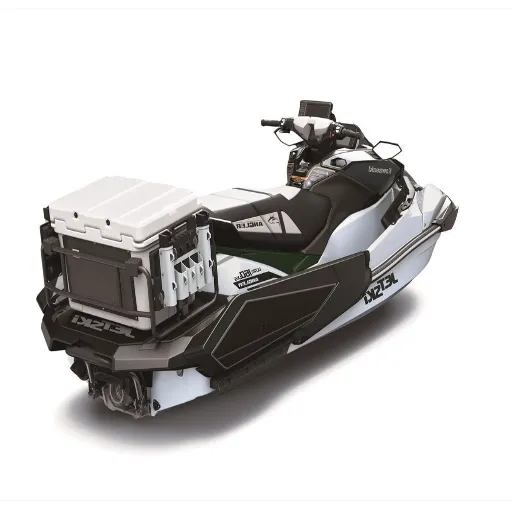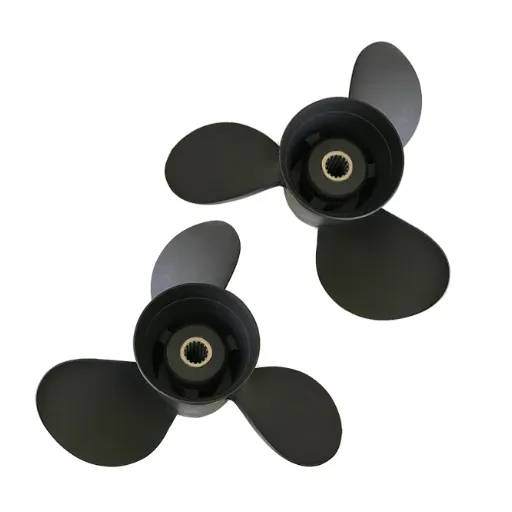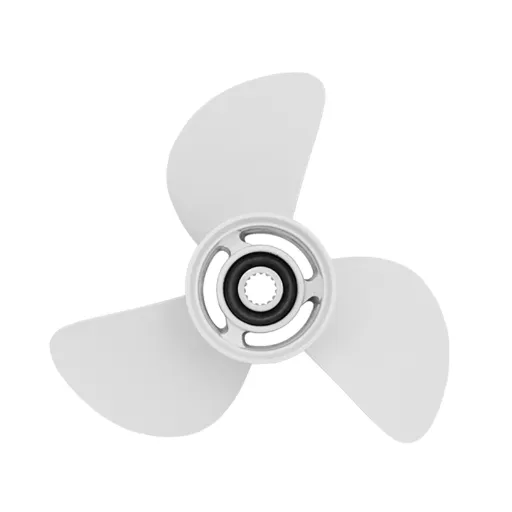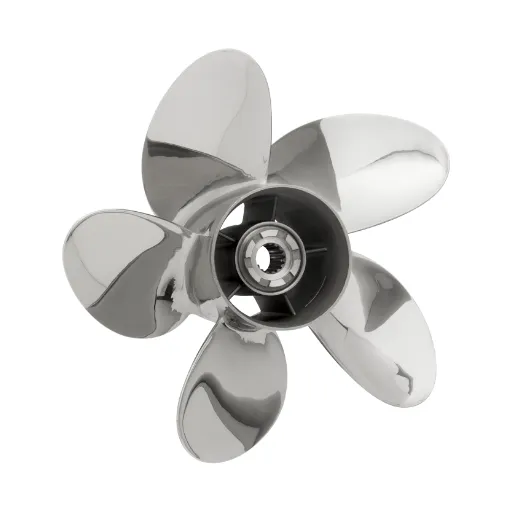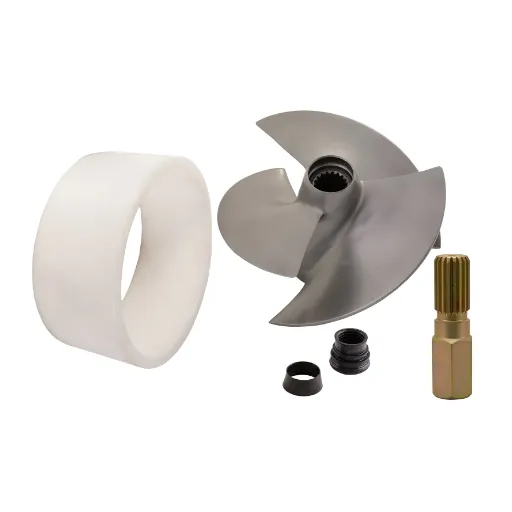In the world of wild, adrenaline-filled adventures, jet skis truly glide alongside intrepid souls ready for the roller coaster of water sports. Come 2025, very few jet skis will stand tall in comparison to the new kid claiming to be the fastest and redefining the entire high-performance landscape of watercraft. This article delves into the jet ski that leads the industry through never-before-seen technology, cutting-edge engineering, and absolute power, explaining why it rules not just the waterways but the hearts of people worldwide. So if you’re a competitive racer, a tech geek, or just a high-speed thrill junkie, you’ll understand how the newest toy has set a precedent for all others to follow.
Introduction to Fastest Jet Skis
Understanding Speed in Personal Watercraft
When determining the speed of a personal watercraft, a range of factors come into play, including engine power, hull design, weight distribution, and advanced technological applications. The modern jet ski is usually equipped with high-performance engines, typically ranging in horsepower from 150 to well above 300, enabling it to reach speeds of over 65 mph at maximum. Hull construction has undergone significant innovations, utilizing lightweight composite materials to reduce drag and employing aerodynamic design for improved steering at high speeds.
Engine Power
150-300+ HP
High-performance range
Top Speed
65+ MPH
Maximum achievable
Hull Technology
Composite
Lightweight materials
In addition, for improved propulsion and a smoother ride, the water intake systems and impeller designs have been optimized by this set of features. There are also adjustable trim systems installed that allow the user to adjust the watercraft’s performance as required, i.e., cruising on a glass-smooth lake or chopping through ocean waves. These fastest jet skis today are at the apex of precision, power, and engineering, still delivering a rush to their riders and pushing the technology forward.
These sorts of advancements ensure that the jet skis can offer an edge in speed, while also prioritizing safety, stability, and control, so that the rider can be pretty confident in such a high-speed ride.
Overview of Jet Ski Brands
The jet ski market is dominated by a few well-established brands, each catering to distinct performance and recreational or professional needs. Below is an overview of some of the leading players:
Kawasaki Jet Ski
The personal watercraft (PWC) industry was initiated by Kawasaki, so alongside the Jet Ski, the company continues to maintain a prominent position. The company is known for its high-performance Ultra series watercraft, which feature the fastest speed, endurance, and advanced features such as GPS integration and adjustable handlebars. Their engines are powerful, supercharged engines designed for pure enjoyment by thrill chasers and racers.
Sea-Doo (BRP)
Sea-Doo, under BRP, has earned a reputation for innovation and design that prioritizes the user. Sea-Doo caters to all levels of skills with a wide range of models in the recreational, touring, and performance categories. Features such as modular storage options, the intuitive control system (iBR), and green engines make it an all-around good choice. The affordable Sea-Doo Spark is quite popular among beginners.
Yamaha WaveRunner
The WaveRunner series by Yamaha is most trusted when it comes to reliability and durability. The brand promotes smooth handling and a high degree of performance over an extended period, with Yamaha PWCs boasting advanced hull designs, including NanoXcel technology, and a TR-1 HO engine built for reliability. Safety thus remains at the top of their list of priorities, including features like RiDE technology that enhance maneuverability and braking.
Krash Industries
As makers of stand-up freestyle jet boats, Krash is a niche manufacturer that builds lightweight yet rugged boats that are perfect for tricks and stunts. Their customization options are a hallmark of their appeal for advanced riders looking to unlock new performance capabilities.
TaoTao
The frugal alternative, TaoTao, makes headlines for producing inexpensive PWCs for casual users. While they may not have all the high-end features of other high-end brands, a TaoTao is dependable enough to get those starting in jet skiing or those looking for more economical options on their feet.
Each of these brands emphasizes innovation and quality, prioritizing customer satisfaction, so options are made available that meet the needs of everyone, from occasional recreational family outings to water sports competitions. By understanding the few differences presented by these manufacturers, the potential buyer can make a more informed choice, taking into account their interests, abilities, and usage.
Importance of Acceleration and Top Speed
Acceleration and top speed stand out as essential traits that directly impact performance and are therefore the key characteristics that inform consumer choice. An adequate acceleration would mean fast responsiveness, and it would be beneficial for sharp turns, wave dodging, or even competitive racing scenarios. The other aspect is top speed, which determines the maximum pace at which a jet ski can travel, and this is often seen as something that many thrill seekers and performance enthusiasts are particularly concerned about.
| Performance Aspect | Speed Range | Best For | User Type |
|---|---|---|---|
| Quick Acceleration | 0-50 mph in seconds | Sharp turns, wave dodging | Competitive racers |
| Top Speed | 50-70 mph | High-speed thrills | Performance enthusiasts |
| Controlled Speed | 30-45 mph | Safe, controlled rides | Recreational users |
Top speeds of between 50 and 70 mph are what many jet skis, by modern standards, have been designed to achieve, thanks to advancements in engine technology and aerodynamic design. While hull construction provides greater lift, with a lightweight constitution suitable for quick acceleration and maneuvering agility, recreational users may prefer slower acceleration for a safer, more controlled ride, whereas professionals may demand the fastest acceleration in a race that means everything. With this knowledge, a potential purchaser can weigh the models against their individual requirements: a leisure cruise or a high-speed thrill.
Fastest Jet Ski Models of 2025
The 2025 Sea-Doo RXP-X 325: An Industry Game Changer
🏆 2025 Sea-Doo RXP-X 325
The Ultimate Speed Machine
The forthcoming 2025 Sea-Doo RXP-X 325 embodies the essence of speed and innovation in the personal watercraft segment. It is powered by a state-of-the-art Rotax 1630 ACE engine churning out a massive 325 hp. Incredible speed and power are its prime candidates. Keeping the hull exceptionally light through Polytec GEN 2 materials allows riders to glide across the water with agility, even at high speeds. The Ergolock seating system also adds comfort and control to the ride, allowing reduced rider fatigue during long rides while enabling very agile and sharp maneuvers on competitive rides.
⚡ Engine Power
Rotax 1630 ACE engine delivering 325 horsepower for incredible speed and acceleration
🏗️ Hull Construction
Polytec GEN 2 materials for exceptional lightness and water agility
🪑 Seating System
Ergolock seating for comfort, control, and reduced rider fatigue
🛠️ Smart Features
Intelligent braking and reverse (iBR) for precision stopping and docking
A feature shared by this model is the addition of intelligent braking and reverse iBR, which allows for high precision when stopping or landing a dock-a feature that highly appeals to both recreational and professional users. Users will appreciate the digital dashboard, which provides real-time performance statistics, GPS navigation, and the ability to customize it according to the type of riding they prefer. Another attractive feature is the innovative hull design, which provides absolute stability and precision, positioning the RXP-X 325 at the forefront of speed and safety. If seeking great adrenaline rushes to excellent maneuverability, the 2025 Sea-Doo RXP-X 325 is indeed supposed to be at the summit of personal watercraft engineering.
Comparative Analysis of Watercraft Models
When considering watercraft models on the market, the 2025 Sea-Doo RXP-X 325 stands out with its potent combination of power, stability, and design flexibility. Other top personal watercraft, such as the Yamaha GP1800R SVHO and the Kawasaki Jet Ski Ultra 310LX, highlight the differences in performance, technology, and customization compared to this one.
| Model | Horsepower | Top Speed | Key Strength |
|---|---|---|---|
| Sea-Doo RXP-X 325 | 325 HP | 68+ mph | Power + Technology |
| Yamaha GP1800R SVHO | 250 HP | 67 mph | Handling + Reliability |
| Kawasaki Ultra 310LX | 310 HP | 69 mph | Durability + Power |
🚀 Performance and Speed
This RXP-X 325, powered by the revolutionary Rotax 1630 ACE engine producing 325 HP, offers exhilarating acceleration and a notable top speed that goes toe-to-toe with or even more than what other PWC of its class exhibit. The Yamaha GP1800R SVHO, despite being equipped with the highly respected SVHO engine, actually generates less horsepower: 250 HP, and thus has somewhat less top speed. The Kawasaki Jet Ski Ultra 310LX, on the other hand, features a powerful supercharged engine producing 310 HP; however, it lacks the lightweight agility and responsive handling required during challenging water conditions.
⚖️ Stability and Precision
The T3-R hull is an innovative design by Sea-Doo that offers premium-grade stability, providing the rider with more control at high speeds and enabling them to corner exceptionally well. Therefore, one could say that this design maintains the level of RXP-X 325 both in calm and challenging waters. On the opposite side, Kawasaki Ultra 310LX claims durability and the ability to cut through waves but feels somewhat bulky in tight maneuvers, while the Yamaha GP1800R SVHO seems to react better in handling but sometimes relinquishes stability during aggressive turns.
💻 Technological Advancements
Another feature that stands out in the RXP-X 325 is its advanced digital dashboard, which features real-time performance metrics, GPS integration, and configurable ride modes adjusted according to various preferences and water conditions. Digital displays in Kawasaki and Yamaha models, although present, are nowhere near as user-customizable and intuitive as the one in the new Sea-Doo. On the other hand, the ErgoLock seat of the RXP-X 325 provides comfort and control to the rider, which is highly appreciated among enthusiasts who use the craft for marathon runs in the water.
💰 Pricing and Value
The RXP-X 325 calls itself premium; if even the performance and feature set could not justify that label in the minds of serious riders, then it would not sell at all. On the contrary, Yamaha GP1800R SVHO offers a much cheaper option while being stripped off the one or two top-tier features of an X 325. The Jet Ski Ultra 310LX by Kawasaki puzzles much the same segment, but emphasizes power and size over perfectly handled and rider-customized features.
Above all, the Sea-Doo RXP-X 325, introduced in 2025, stood at the forefront of innovation in personal watercraft, excelling in performance, stability, and technological advancements. While Yamaha GP1800R SVHO and Kawasaki Jet Ski Ultra 310LX bring their respective strengths to the table, the RXP-X 325 remains the ultimate choice when high-class performance and high-tech features are sought after, hence solidifying its lofty perch as a modern watercraft.
Recent Evolution of Top Speed in Models
The principal performance attribute is speed, and the 2025 lineup actually lives up to expectations.
Sea-Doo RXP-X 325
68 MPH
325 HP Rotax Engine
Yamaha GP1800R SVHO
67 MPH
NanoXcel2 Hull Design
Kawasaki Ultra 310LX
69 MPH
Supercharged 1,498cc Engine
With an advertised 325-horsepower Rotax engine, the Sea-Doo RXP-X 325 is capable of hitting a top speed of 68 mph under ideal conditions, offering thrill-seekers unparalleled excitement. Acceleration-wise, the Yamaha GP1800R SVHO goes neck-and-neck with an almost identical 67 mph top speed, but thanks to its NanoXcel2 hull’s lightweight construction and snap handling. Meanwhile, the Kawasaki Jet Ski Ultra 310LX, powered by a supercharged 1,498cc inline-four engine, holds the crown for top speed on the interstate at 69 mph.
While pushing the boundaries of speed, these models furthermore endorse the advances in stability and control to smooth out the winning experience. As a matter of fact, whose T3-R hull, Yamaha’s Race-Inspired Intake Grate and Kawasaki’s Deep-V Hull ensure performance with confidence at speed. Hence, the emphasis on speed, safety, and engineering precision crowns these manufacturers as key authorities in modern marine innovation and competitive performance specifications.
Technological Innovations in Jet Skis
Engine Advancements for the 2025 Sea-Doo RXP-X
🔧 Rotax 1630 ACE Engine Technology
Advanced Combustion Efficiency
Due to the Rotax 1630 ACE (Advanced Combustion Efficiency) engine delivering 325 horsepower, the 2025 Sea-Doo RXP-X stands as a benchmark of performance for watersports, competing with any personal watercraft. Offered with superior acceleration and top-end speed, this is undoubtedly one of the most potent engines for watercraft use. Offering innovations of its own, the closed-loop cooling system monitors temperature to maintain even performance, while also reducing exposure to salt and debris for enhanced longevity.
⚡ Performance
Superior acceleration and top-end speed with 325 horsepower output
🌡️ Cooling System
Closed-loop system monitors temperature for consistent performance
⛽ Fuel Economy
Refined combustion reduces energy loss for improved efficiency
🎮 Throttle Response
Enhanced control for aggressive maneuvers and tight turns
Furthermore, there is increased attention to the fuel economy through refined combustion and reduced energy loss. The lightweight nature of the engine, combined with fewer drag-inducing materials, makes the craft much easier to manage. Improvements in throttle response allow riders on the 2025 RXP-X to exert finer control during aggressive maneuvers and tight turns. With such innovations, and combined with Sea-Doo’s trademark reliability, power, efficiency, and excitement, the 2025 RXP-X would be unparalleled on water.
Methods of Technology Affecting Performance and Speed
Technology advancements have redefined the performance and speed equation for personal watercraft such as the 2025 RXP-X. Innovative engine designs offer maximum efficiency with peak acceleration rates without compromising fuel economy. For instance, the use of new materials, such as carbon fiber and advanced composites, helps lighten the particles, allowing for high speeds while maintaining structural strength. Digital throttle systems, in other words, provide split-second response time, ensuring perfect power delivery, which increases the precision of the handling. Similarly, hull designs have been analyzed using computational fluid dynamics to optimize hydrodynamics, minimizing drag while maintaining stability even in choppy water. With all these technologies coming together, there has been no competition to the rider’s speed or control prowess, setting a new benchmark for high-performance watercraft.
Advanced Materials
- Carbon fiber construction
- Advanced composites
- Lightweight particles
- Structural strength maintenance
Digital Systems
- Split-second throttle response
- Perfect power delivery
- Precision handling control
- Enhanced maneuverability
Hull Design
- Computational fluid dynamics
- Optimized hydrodynamics
- Minimized drag
- Choppy water stability
2025 Trends in Personal Watercraft Design
With 2025 primarily focusing on sustainability in personal watercraft design, manufacturers are striving to incorporate more eco-friendly materials and improve fuel efficiency without compromising performance. Some of the lightweight composites being used include carbon fiber reinforced with biorenewable resins; these materials decrease environmental production impacts but increase the agility and speed of the craft. Meanwhile, electric propulsion is proving itself more and more, with improved battery technologies. The everyday usage of these now comes with longer ranges, faster charge times, and greater energy efficiency, thus posing a possible application for conventional and internal combustion engines.
🌱 Sustainability Focus
Eco-friendly materials and improved fuel efficiency without performance compromise. Carbon fiber reinforced with biorenewable resins reduces environmental impact while enhancing agility and speed.
🔋 Electric Propulsion
Improved battery technologies offering longer ranges, faster charge times, and greater energy efficiency, challenging conventional internal combustion engines.
📱 Smart Integration
Connected systems with real-time diagnostics, GPS navigation, and app-based customization. Advanced safety features including automatic collision avoidance and speed control.
Another dominant trend places a strong emphasis on smart technological integration, resulting in connected systems that amplify the user experience. Users can diagnose in real-time; they receive navigation through GPS and customize their craft with the help of an app, so they can be constantly aware of performance and tailor it to suit the conditions. More safety features, including automatic collision avoidance and speed control, reassure both the inexperienced and the seasoned driver. The convergence of high performance, eco-friendliness, and state-of-the-art technology marks a watershed in the evolution of personal watercraft, enhancing usability and accessibility from the perspective of the tech-savvy and eco-conscious customer.
Market Insights and Consumer Preferences
A Look at Water Sports Trends and Jet Ski Popularity
In recent times, water sports have become a popular recreational activity, combining physical activity, relaxation, and adventure. Jet Skis have always been the subject of consistent interest owing to their accessibility and thrill-seeking appeal. Interestingly, the surge in consumer consciousness about environmentally friendly and electric watercraft has coincided with global sustainability efforts. With coastal tourism on the rise, along with waterside vacationing, demand for rentals of personal watercraft is increasing, with businesses reporting steady growth.
📈 Market Growth
Coastal tourism and waterside vacationing drive increasing demand for personal watercraft rentals with steady business growth.
🌱 Sustainability
Growing consumer awareness of environmental impact drives interest in eco-friendly and electric watercraft options.
📱 Social Media
Users share jet ski adventures on social platforms, increasing aspirational value and driving interest in the sport.
Seasonal trends cause peaks in jet ski-related operations during the warm months as individuals and families seek beyond-the-ordinary outdoor activities. Enthusiasts prioritize highly performing and reliable models with cutting-edge features, such as innovative technology integration, advanced safety systems, and improved fuel efficiency. Social media is undoubtedly an active contributor to this trend, as users post their social media content on jet ski adventures, increasing its aspirational value.
Consumer Reviews and Performance Metrics
The major areas for consumer feedback on existing jet ski models are the jet ski’s performance, ease of operation, and onboard technology. Many users cite the seamless integration of innovative features, such as GPS navigation and Bluetooth audio systems, as factors that set the experience apart for them. Additionally, safety features such as intelligent throttle control and stability systems are widely praised for inspiring confidence in the discerning rider, especially the novice.
🎯 Performance Focus
Users prioritize engine efficiency, durability, and horsepower improvements. Modern jet skis with high horsepower appeal to eco-conscious consumers concerned with fuel economy.
💻 Technology Integration
Seamless integration of GPS navigation, Bluetooth audio systems, and customizable digital dashboards enhance the user experience significantly.
🛡️ Safety Features
Intelligent throttle control and stability systems inspire confidence, especially among novice riders seeking secure high-speed experiences.
⚡ Reliability
Customer satisfaction surveys emphasize reliability, translating to less maintenance and longer lifespan compared to older models.
Performance parameters form the basis of such reviews, indicating the timing of the engine’s evolutionary improvement in terms of efficiency and durability. For example, modern jet skis with their enormous amount of horsepower will usually appeal to the eco-conscious consumer, who is concerned with fuel economy. Models with a technological hull design are reported to ensure the best handling in various water conditions, including both rough and calm ones, such as those found on a seashore. Additionally, customer satisfaction surveys often emphasize reliability, which translates to less maintenance and a longer lifespan compared to older models.
These results reflect the increased expectations of buyers, who consider a range of stimulant factors, from utility to entertainment and sustainability. Traders and manufacturers who concentrate on innovation and user features, as suggested by such trends, might be at the top of today’s market and fairly well suited for contemporary men forced to adventure.
Future of Jet Skis in Competitive Racing
Based on developments in technology, current trends, and worldwide awareness of the sport of jet ski racing, the future for jet skis looks tremendously bright. Manufacturers are increasingly interested in integrating the latest innovations, such as electric propulsion systems, to present racing markets with environmentally friendly, high-performance models. Besides emitting low emissions, electric jet skis provide a significant boost in torque and acceleration, giving athletes the winning edge.
🌍 Global Expansion
Governing bodies worldwide are increasing the sport’s reach with more international tournaments and growing participation numbers.
📺 Digital Engagement
Increased viewer interaction through live broadcasts and online streaming platforms appeals to younger digital generations.
🔧 Advanced Technology
GPS systems, real-time telemetry, wearable technology, and AR applications transform training and competitive experiences.
♻️ Sustainability
Adoption of renewable energy sources and zero-waste policies make competitive sports greener and more environmentally responsible.
The governing bodies worldwide are still attempting to disseminate the sport, while international tournaments are being hosted in more countries and growing participation. Signifying the sport’s growth, the IJSBA has witnessed a rising number of entries over recent years. Another piece of information reveals increased viewer interaction with live broadcasts or online streaming platforms, highlighting the appeal of this adrenaline-motoring sport to the younger digital generation.
Meanwhile, new-age navigation and telemetry technologies find their way into the races for strategic and safety purposes. Through GPS systems, racers can improve their course-routing decisions, while the broadcast of real-time performance data adds to the critical decision-making process for racers and teams. In the realm of innovation, there remains more to explore. Wearable technology, along with AR (augmented reality) applications, may transform the training and competitive experience of racers into an immersive world tailored to their skills in the near future.
In these racing venues, the adoption of sustainable practices is becoming an increasingly important criterion: conversion to a renewable source of energy for all operations and a zero-waste policy for the environment. Based on performance and sustainability, this could culminate in a step toward making competitive sports greener.
All in all, the exciting outlook for the future of jet ski racing is shaped by the combination of advanced engineering, the globalization of the sport, and its sustainability dimension. In evolution, the sport first gains broader appeal and then begins to push the boundaries of what can be accomplished in watercraft and athletic competition.
Conclusion: The Fastest Jet Ski of 2025
Performance and Feature Summaries
Indeed, by investigating the fastest jet ski of 2025, one appreciates the remarkable blend of speed, innovation, and conservation. The performance reflects advanced engineering, complemented by a state-of-the-art propulsion system, which enables rapid acceleration and achieves an impressive top speed. There are improved aerodynamics for better stability and agility, thereby guaranteeing smooth rides even when challenged by harsh conditions. This configuration allows for a considerate integration of capacious and eco-friendly batteries, which confer an additional advantage in efficiency against the rising demand for greener solutions in the field of motorsports.
🚀 Performance Excellence
Advanced engineering with state-of-the-art propulsion delivering rapid acceleration and impressive top speeds with enhanced stability.
💻 Smart Technology
Adaptive ride control, intelligent navigation systems, and user-centric features designed for safety and precision on water.
🌱 Eco-Conscious Design
Lightweight construction from durable, sustainable materials with eco-friendly battery integration for environmental responsibility.
This jet ski goes beyond performance into a suite of innovative technologies designed to elevate the user experience. Everything, from adaptive ride control that adjusts maneuvers according to the rider’s skill level to intelligent navigation systems designed to maximize safety and precision on the water, has been thoughtfully designed. The lightweight construction, derived from a philosophy of durable and sustainable materials, is itself a factor for smooth handling and incorporates an eco-conscious goal. This jet ski becomes a trailblazer, combining power, innovative technology, and a user-centric, feature-laden design for athletes and decadents.
Looking back at the design and features, I would confidently state that this model has set a new standard in the world of jet ski racing and recreational watercraft. It does not merely strive to be the fastest; it aims to push the limits of aquatic sports, delivering an exhilarating experience while being environmentally conscious. For riders seeking that rare balance between next-level performance and sustainability, this jet ski is the complete package and will remain prime through 2025 and beyond.
Final Say on the Sea-Doo RXP-X 325
For me, the Sea-Doo RXP-X 325 sets a new thrilling standard in the world of jet ski racing and recreational watercraft. It is the perfect combination of unmatched speed, stellar performance, and advanced technology, providing inspiring moments on the water for riders. What stands out the most is how innovatively it blends the thrill with sustainability, making it a clear contender for ecologically conscious innovation. With precision handling and brute force, it falls into two distinct categories for users: racing competitively and having leisurely fun.
From my perspective, this jet ski goes rather beyond being a mere high-performance machine-it solidly states the future of aquatic sports. Sea-Doo has evidently given the evolving needs of its riders prime consideration in offering a product with no compromises in terms of performance or environmental impact. In this way, the RXP-X 325 embodies a forward-thinking approach to high-octane fun, incorporating sustainability considerations. A balance like this is what really makes the investment worthwhile for any true enthusiast.
Looking Ahead: The Future of Fast Jet Skis
The perfect future scenario for fast jet skis would involve integrating top-end performance with sustainable innovation. Manufacturers such as Sea-Doo are spearheading this movement by introducing models like the RXP-X 325, which offers unprecedented speeds and agility whilst being kind to the environment. I believe that electric propulsion systems and environmentally friendly materials will largely define the future of watercraft. Reducing drawbacks such as emissions and noise pollution will be an essential step towards establishing a balance between adrenaline-raising recreation and responsible leisure activities.
🔋 Electric Future
Electric propulsion systems and eco-friendly materials will define watercraft development, balancing performance with environmental responsibility.
📱 Smart Connectivity
Advanced GPS, real-time performance tracking, and smartphone app controls will become standard on high-tech jet skis.
🌐 Community Features
Digital communities for performance sharing, skill improvement, and participation in virtual competitions will enhance the sport.
The other key element in future enhancements is the connectivity and integration of innovative technology. I foresee advances such as an improved GPS, real-time performance tracking, and controls via a phone application becoming standard on high-tech jet skis. The addition of such features not only arguably offers a good experience to the user but also provides riders with the chance to inspect their performance and work on improving their skills while enjoying some water time. While imagining a scenario where one can connect and share their performances and data with a community of fellow enthusiasts or participate in digital competitions adds a factor of excitement to the sport.
Ultimately, we can envision a future for fast jet skis if we consistently put the onus on innovation while giving attention to rider safety, environmental impact, and overall experience. I am optimistic that brands will rise to the challenge of turning the current dream of high-performance, eco-friendly, and technology-imbued watercraft into a reality. The possibilities are limitless, and as an enthusiast of aquatic sports, I eagerly anticipate seeing how far the industry can evolve.
Reference Sources
-
8 Best Personal Watercraft (Jet Skis) for 2025 – Boating Magazine: Highlights the Sea-Doo RXP-X 325 with its 325hp Rotax engine, known for its record-breaking horsepower.
-
Best Jet Skis in 2025 | Buyer’s Guide – Boat Sail Mag: Features the Sea-Doo RXP-X 325 as the fastest jet ski on the market, emphasizing its powerful 325-horsepower engine.
-
2025 Kawasaki Jet Ski® Ultra® 310LX-S – Kawasaki: Showcases the Kawasaki Jet Ski Ultra 310LX-S with a 1498cc supercharged engine, offering high performance and advanced features.
- Click here to read more.
Frequently Asked Questions (FAQs)
What are the fastest jet skis that nature has to offer?
The quickest jet ski as of 2023 would be the 2025 Sea-Doo RXP-X 325 RS, which holds a speed potential in excess of 70 mph. This high-performance kit for a personal watercraft is equipped with a supercharged engine, enhancing both the speed and handling of this particular watercraft. It is considered by many as among the best choices for thrill seekers who want to travel at breakneck speeds. The RXP-X 325 transports you beyond a narrow speed limit due to its highly engineered aerodynamic hull and lightweight frame. Sea-Doo has also given it a technological edge, enabling it to perform well under varying water conditions.
Besides this, how does the Yamaha FX SVHO compare to other fast jet skis?
The Yamaha FX SVHO has established a reputation for outstanding and reliable performance and comfort, thanks to its super vortex high-output engine, which produces 310 bhp. While it may not be the fastest jet ski, an average top speed of about 67 mph can be attained under the right conditions. The FX SVHO is most favored by those who value stability and ride quality, as they prefer it in rough conditions. The seat is spacious enough for three passengers, making it an excellent option for families and groups. Performance-wise, the Yamaha FX SVHO consistently excels at the intersection of speed and comfort.
What features make the 2025 Sea-Doo RXP-X 325 RS a much faster jet ski?
Several features offered by the 2025 Sea-Doo RXP-X 325 RS enhance its speed and performance. Its supercharged motor assists phenomenal acceleration, hitting 70 mph in a matter of seconds. The RXP-X 325 Rs comes equipped with a highly developed air intake system, alongside an impeller of the newest design, thereby maximizing the velocity achieved by the water flow. It is designed to be exceptionally slim and race-built, thereby resulting in high maneuverability and response characteristics. These traits make the craft more suited for skilled riders rather than beginners. Additionally, the steering damper ensures stability at high speeds, allowing for smooth steering even on the rough side of the water.
So, how does the Kawasaki Ultra 310 stack up against the fastest jet skis?
Another, arguably the fastest jet ski in its own right, is still revered with the Kawasaki Ultra 310. With a power-generating capacity of 310 horsepower, the engine gallops with swift efficiency. Stock jet configurations enable the Ultra 310 to achieve a thrilling feat, attaining a maximum speed of approximately 67 mph, standing tall among PWC race contenders. What makes the Ultra series special, and should continue to do so, is its ruggedness in terms of manufacturing and capability to handle rough conditions, thus appealing to the rider who enjoys rewarding their explorations with riding on various types of waterscapes. Speed-tamed by balancing width, the Ultra 310 is well-suited to provide comfort to a multitude of passengers.
What significance does horsepower rating hold in personal watercraft?
Horsepower stands as the very measure of PWC performance and speed. Increasing the horsepower rating results in improved acceleration and increased speed. Take, for example, the Yamaha GP1800R SVHO: with a mighty 310 hp, it promises to be one of the fastest jet skis on the market. However, speed alone does not guarantee a fantastic jet ski; factors such as handling, stability, and ride quality play crucial roles in determining its overall quality. In other words, riders should look for a balanced amount of horsepower and a suitable design of the craft that will allow them to have more fun on the water.
What jet ski models go for the experienced riders on the fast side?
While experienced riders seeking speed may opt for higher-performance models like the Sea-Doo RXP-X 325 RS and the Yamaha GP1800R SVHO, these models are designed for race-ready performance, where the feature set prioritizes speed and handling. The Sea-Doo RXP-X 325 RS, equipped with a supercharged engine, offers excellent acceleration and stability. The Yamaha GP1800R SVHO, a lightweight model with high power, stands as one of the fastest jet skis available. These models offer the technical features expected by experts who are ready to push the limits of excitement on the water.




